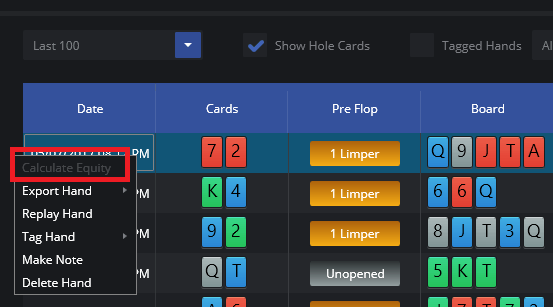

Works consulted for writing this article:ĭeRoos, Jan, and Rushmore, Stephen.
Poker equity calculator per street basis how to#
If you have further questions or specific scenarios that don't quite fit these methods such as really small boutique hotels/B&Bs or unique hotels, feel free to reach out to me and I'll do my best to point out how to adapt these rules of thumb calculations to your situation. In this case, the 60-second valuation will have served its purpose - naturally, there are many other more precise methods to consider if it turns out the transaction warrants further analysis. If you were really considering our ‘imagined’ example hotel to either purchase or price to sell, then the best starting point would be to quickly calculate all three approaches giving us three different values of 1) €4,900,000 2)€5,250,000 & 3)€5,075,000 so unless the asking price (in case of buying) or expectation (to sell) is nearby or under these values, we should move on and consider other options. The downside of this approach is that it assumes that all rooms are created equal, not considering very important factors such as the revenue each room generates, the quality of the construction and FF&E (Furniture, Fixtures & Equipment), something as subtle as the underlying incentives of that previous purchase, or a political event, such as Brexit or anything that does have an effect on the market at the time the comparable transaction was/is taking place. This allows as close a scenario as possible to the above mentioned apartment hunt when it comes to hotels. The same applies to hotels but since rarely two are similar this is a very general approach that essentially considers nothing but historical sales price divided by the number of rooms. If several with similar, if not identical, conditions were selling/renting for one price you would not pay more for another without a specific reason as to why it's above the market ask. Especially if we are talking about a high rise with many virtually identical options.

If you have ever shopped around for an apartment or even to rent one you might remember how easy it was to determine the market value.

This boils down to €145,000 PPR, so a 35 room hotel should be around €5,075,000. Essentially all you need to do is divide the total sales price by the number of rooms to arrive at a PPR (Price Per Room) value.Īn example would be if you were considering buying the 35 hotel we have been discussing and you know/discover that 6 months prior, just a few blocks away a much larger 100 room hotel sold for €14,500,000. This technique allows you to compare apples to oranges (sort of) by breaking down historical hotel sales to a per room basis making possible the ‘unfair’ comparison of a 100 room hotel sale to a 35 room hotel sale, for example. However, since we live in a complicated one, we must simplify as much as possible and when it comes to hotels, we must break it down to rooms typically. In a simple world, you’d be able to compare the sale/purchase of the hotel in question to a previous sale with the exact same conditions. Moreover, if you have the time or access to these you should just go all the way and do a proper Income Capitalization Approach. But if you have more than 60 seconds then you could calculate the ARPAR (Adjusted Revenue per Average Room) which takes both costs and additional revenues into account. The glaring omissions of using a RevPAR multiple to value hotels are that it does not take into account CPOR (cost per occupied room) or revenues generated outside of rooms such as restaurants, events, parking, spa, etc. However, if you don’t have a ready-made database of hotel transactions and/or KPIs that includes your target (which is highly unlikely) then, fortunately, companies like Christie & Co publish free general reports with KPI’s for the industry which can serve as benchmarks. Both of these are hard to know before engaging in direct conversation with a prospect (if looking to buy) and thus defeat the purpose of a 60 second valuation. RevPAR is calculated by multiplying the ADR by the Occupancy % or by dividing the hotel’s total room revenues by the number of rooms. ADR or Average Daily Rate is one of the better known KPIs (Key Performance Indicators) of the hotel industry and this rule of thumb essentially assigns a worth of 1,000 times the ADR per room, or if you are familiar with the RevPAR (Revenue per Available Room) it also sets the value at 3.5 to 4.5 times the annual room revenues (RevPAR x # of Rooms x 3.5-4.5).Īn example would be if we had a hotel charging on average €140 per room/per night and a total of 35 rooms, that hotel would be worth roughly €4,900,000.


 0 kommentar(er)
0 kommentar(er)
